A letter from the Consul General of Ireland
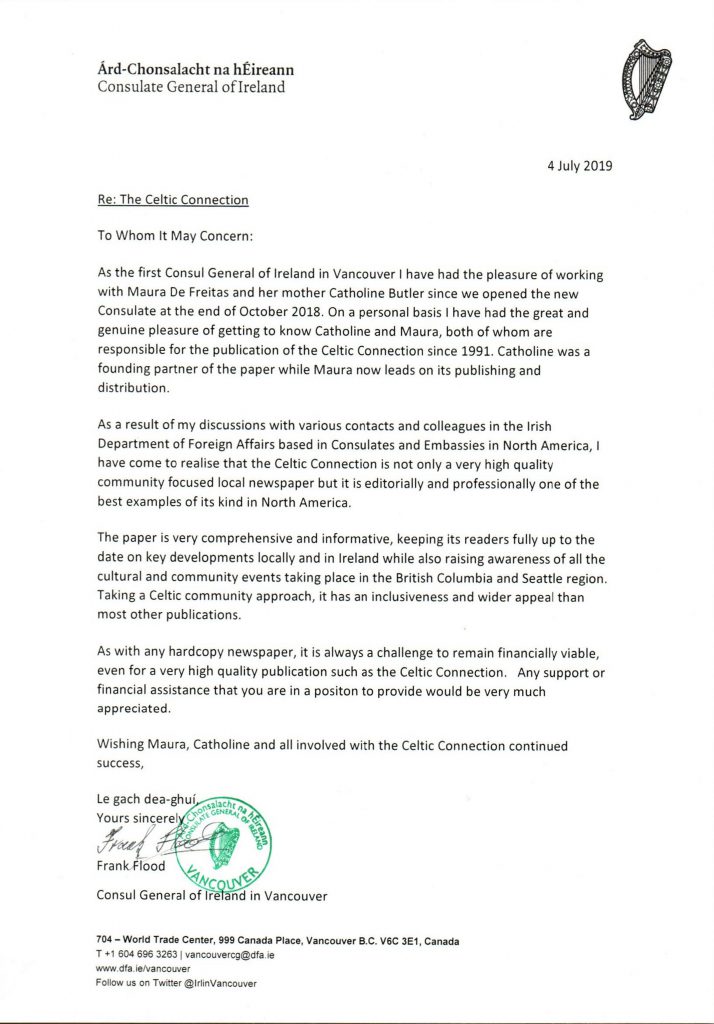

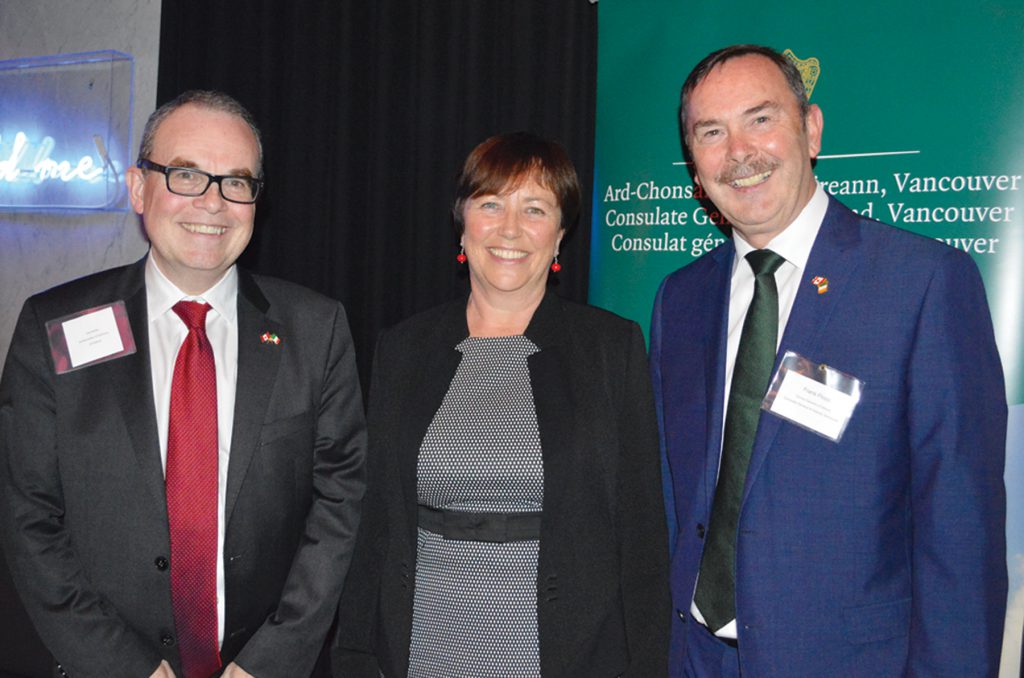
IRELAND’S AMBASSADOR to Canada Jim Kelly with Irish Consul General Frank Flood and his wife Orla in Vancouver following the opening of the new Irish Consulate General in November 2018.
OTTAWA – I write this message in grateful appreciation of the enormous contribution which Maura de Freitas, her mother Catholine Butler and all of the team at The Celtic Connection have made to the Irish community in western Canada, and the U.S. Pacific Northwest over almost three decades.
To produce for so long such a first rate and consistently top quality publication – always informative and interesting in equal measure – is an extraordinary achievement for which you and Catholine deserve great credit.
From the day I came to Canada as Ambassador and first encountered The Celtic Connection, I have always kept a lookout for the arrival of each new issue and would bring it home that same evening for an enjoyable and leisurely read!
Before that though, I had the good fortune to meet with Catholine and Maura much closer to home when they invited Anne and I and our girls to attend and speak at our first community function on arrival in Ottawa.
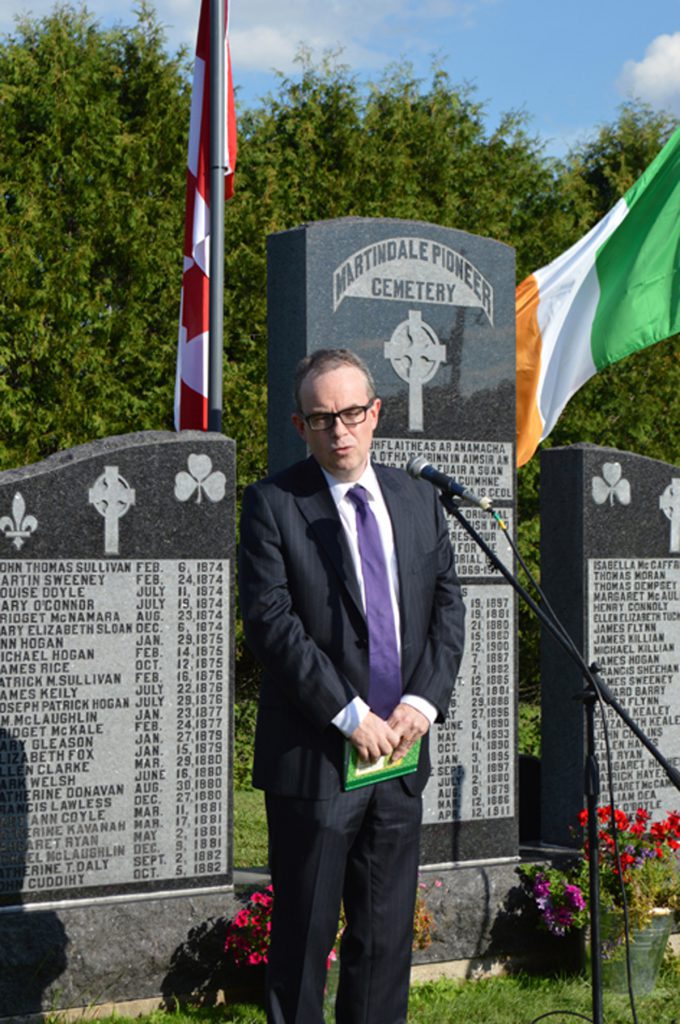
AMBASSADOR Jim Kelly at a dedication ceremony in Low, Quebec on September 18, 2016. This event was held at Martindale Pioneer Cemetery in St. Martin’s Parish now the final resting place for many survivors of Ireland’s Great Famine. This was the first event he attended upon arrival in Ottawa as the new Ambassador of Ireland to Canada.
This was the unveiling of a plaque to honour those (including Catholine) who had worked so hard to erect a poignant memorial at Martindale Pioneer Cemetery, the final resting place of many survivors of the Great Famine who had settled in the Ottawa Valley.
Our visit to Martindale on that sunny Sunday afternoon in September 2016 will remain a treasured family memory of our years in Canada, as we move on shortly to our new posting in New York.
I know that our Consul General in Vancouver, Frank Flood, and Vice Consul Jennifer Bourke are very appreciative too of the strong support that they have received from Catholine and Maura since the opening of the new Consulate in Vancouver.
Frank and his wife Orla have fond memories of their visit with Catholine and Maura just after their arrival in Vancouver, when they enjoyed tea and cake and heard first-hand of how The Celtic Connection was produced from such a family home full of warmth and love and books!
What really impressed them was not just how such a top quality paper was produced without any formal office space but also the stories of how it was distributed wherever there is an Irish community or venue in British Columbia.
On my visits to Vancouver, I always found Maura was a willing and generous source of valuable advice and insight.
For Frank too as our first Consul General in British Columbia, Maura was the proverbial font of wisdom and knowledge!
Whenever the Consulate needed to know who to contact, or the background to any issue, Maura always had the answers, could point the way or raise issues that needed to be addressed.
While always supportive, she was ever ready to ask the important questions and to discuss issues of concern.
An invaluable resource for the Irish community for so long, The Celtic Connection also played a key role in raising awareness of the opening of the new Consulate and its activities.
This was particularly the case when Minister Ciarán Cannon visited British Columbia for the St. Patrick’s Day celebrations in 2019.
The Celtic Connection advertised all the events and helped ensure their success including the first Irish Community Family Day event in St. James Hall.
It reported fully and captured the spirit of the occasion with lots of photos while also including a typically comprehensive write up of Maura’s interview with Minister Cannon.
Of course, The Celtic Connection was not just about the Irish as it has always lived up to its name with articles of interest to the Scottish and Welsh communities as well to the Irish in the Seattle area.
The Consulate has built on this engagement and with the support of The Celtic Connection has easily developed links with Scottish and Welsh groups in B.C.
Part of the newspaper’s legacy is that the new Consulate will work to maintain friendly and mutually supportive relations with our Celtic cousins in western Canada.
Through The Celtic Connection, Maura and Catholine provided an invaluable service to the Irish community in western Canada and the U.S. Pacific Northwest over three decades which I am sure will never be matched.
While we will all miss the paper, we wish you both well in your future ventures online and elsewhere.
In the words of the Irish poet and priest, John O’Donohue: “perhaps the art of harvesting the secret riches of our lives is best achieved when we place profound trust in the act of beginning.”
As you look to a new beginning, we know that you will both remain at the very heart of the community that you love in whatever new endeavours lie ahead for you.
Go raibh míle maith agaibh, a chairde.
Heartfelt thanks from all of us.
Jim Kelly, Ambassador of Ireland to Canada.
Our miraculous journey shared with wonderful friends
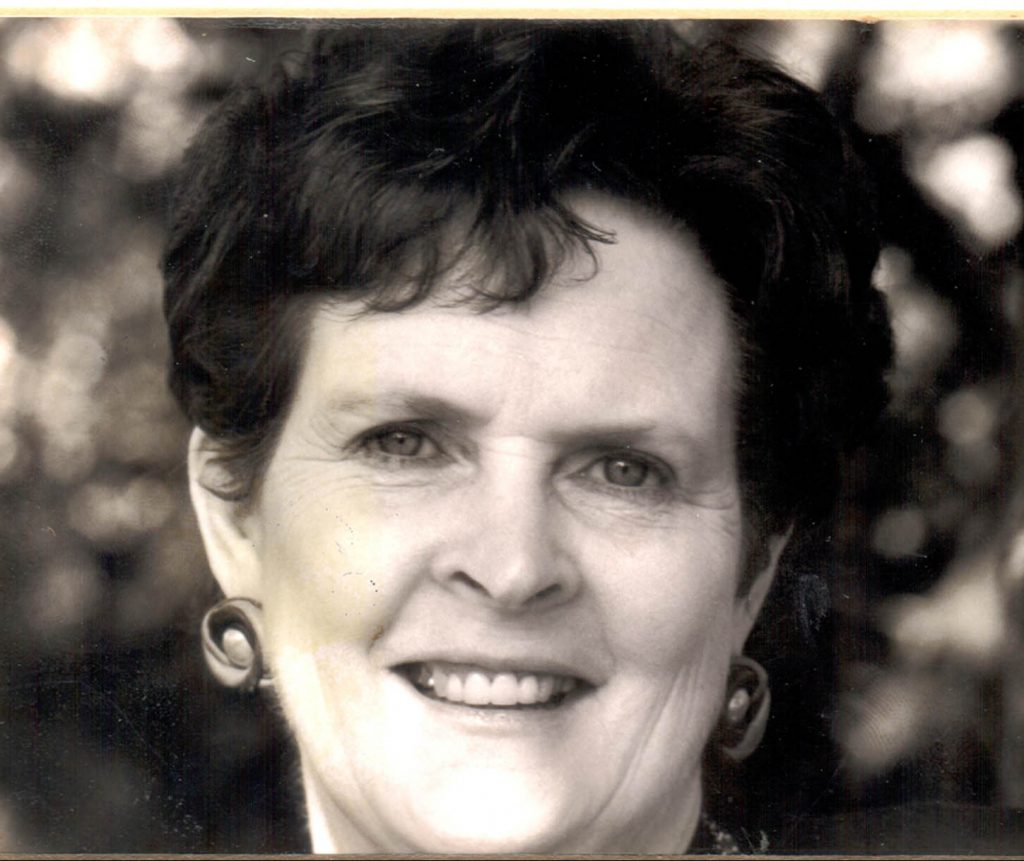
CATHOLINE BUTLER pictured shortly after we launched The Celtic Connection in 1991.
By CATHOLINE BUTLER
On February 24, 2020 when the combined March/April edition of The Celtic Connection rolled off-the-press and was dispatched out we were relieved knowing that it would soon be in the hands of our readers with plenty of time to let them know about all the upcoming St. Patrick’s Day celebrations.
Little did we know that in one short week our lives would be turned upside down and changed utterly… the coronavirus pandemic had arrived!
There would be no St. Patrick’s Day celebrations for 2020. The other crushing reality was that we had just dispatched out our FINAL print edition of The Celtic Connection.
The situation with COVID-19 was traumatic enough, and in fact it remains so, but was this to be the end of The Celtic Connection?
For quite some time now we could see that print media, especially for smaller publications like ours, was becoming increasingly unsustainable but the pandemic has led us to explore other avenues.
One of those avenues is our ‘New Beginning’ website which starts with a reflection on nearly 30 years of history. As with any new undertaking we don’t know where this will lead but it’s an exciting prospect.
Our Dedicated Support Team
From the beginning I was involved with many aspects of the newspaper, this included answering incoming telephone calls, selling advertising, doing interviews, writing articles, and finally managing distribution of the paper.
We would joke among ourselves that we had an unwritten law that no sick time was allowed during production. This included medical procedures and the birthing of babies since everything needed to be scheduled to accommodate our press dates!
Christine Burke, our graphic artist for many years, became pregnant twice while working on the paper. Each time with trepidation we asked her due date before offering congratulations. We all breathed a sigh of relief when her babies accommodated our schedule and waited to be born until after the paper printed.
A number of other great women have also worked on our graphics team over the years, including Christine Byrne, Ainsley Baldwin, and finally Thary Chhom.
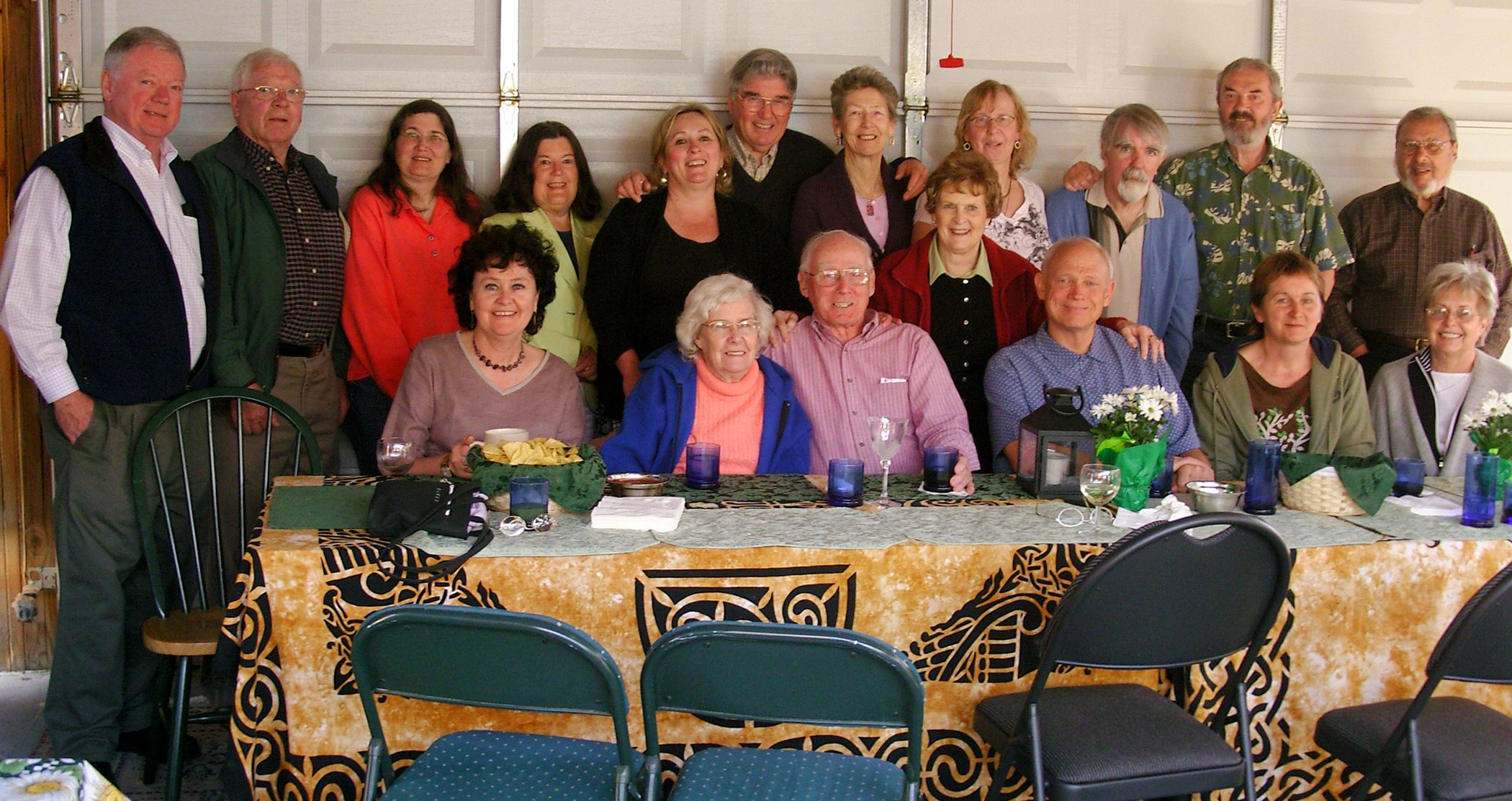
GUESTS at a volunteer appreciation barbeque in May 2009 (L-R) [Standing back row]: Neville Thomas, Tom Butler, Colleen Carpenter, Mavis Williams, Maura De Freitas- McCay (Editor/Publisher), Bill Duncan, Kareen Duncan, Catholine Butler, Joanne Long, Jim Carbin, Kevin Boggan and Eifion Williams. [Seated] Sharon Brown, Bernice Carracher, Bill Carracher, Doug Medley, Stephanie Boggan and Cathy Thomas. [Missing from the photo is Angie Park.]
Offering to volunteer was dangerous because before you knew it you had a job delivering the newspaper in your own neighbourhood.
Over the years, countless people worked to help ensure each issue of The Celtic Connection reached our readers – far too many to mention – but we are forever grateful to everyone for your support.
Some of those on the Celtic team at our office included: Mike Paul of the Scottish Cultural Centre who helped with distribution; Steve Edge of the Rogue Folk Club was both an advertiser and contributor. He loved the tea brack I kept on hand, maybe because I made it with Irish whiskey; Jack Wallace worked on design and layout with Maura; Alicia Martin worked on proofreading and editing; Deirdre Keohane, an Irish/Canadian artist contributed much of the early artwork for our front covers.
Other volunteers in the office included: Teresa Croke; Marie Bruce; and Lucy Cullen. Most days Lucy would bring her lunch to the office. We worked in a heritage building on West Hastings Street and when we opened our windows we had seagulls nesting nearby who would watch us with curiosity. One in particular would sit on our windowsill and watch us working so we named him Percy.
One day Percy seized the opportunity when Lucy opened the window and her lunch was within snatching opportunity. Quick-as-a-wink Percy grabbed the bag and was gone to dine on Lucy’s lunch….we never trusted Percy again after that incident.
To help to sustain the business we sold Celtic jewellery, Claddagh rings, and Bewleys fruit cakes.
Jim Rochfort would often drop by the office and just to get a rise out of me would ask if I had any more of that maggoty cake left. Of course, my cakes were not maggoty and he always bought one. Jim was a great supporter who was also drafted into distribution.
One late night I had a particularly frightening experience when I inadvertently locked myself in the office with a robber.
When I arrived I noticed the door was unlocked and the lights were still on but thought it was probably Richard Carrick, a young fellow who also worked on the paper with us. I called out a hello to Richard a few times but no answer so went around to investigate.
A man suddenly ran out from behind one of the filing cabinets and pushed me into a desk before rushing out the door.
Next, I discovered that our Claddagh rings were gone. When the police arrived they told me I was lucky that I was only shoved out of the way.
This was when I called Maura and told her to come down straight away and bring whiskey!
During those years, we experienced so many touching gestures from people.
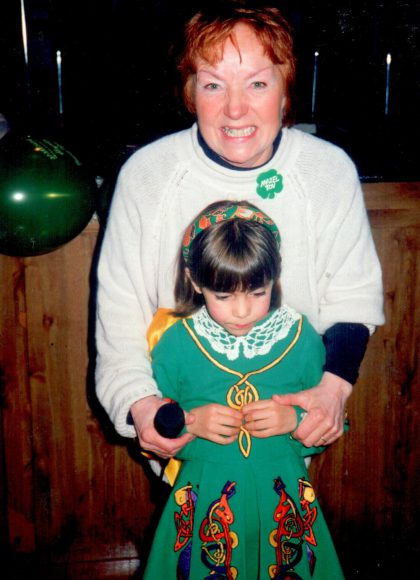
VIOLET MOORE with one of her young dancers with the Moore School of Irish Dance.
On another night in particular, when Maura and I were working late, Violet Moore of the Moore School of Irish Dance stopped by
She asked if we had eaten because she wanted to take us out for dinner. We were hungry and the offer was so very tempting but we were on deadline and so had to decline.
When we first started shipping the papers to Seattle, Brian Keys then-owner of Quick Shuttle Bus said that since we were just trying to get established he wouldn’t charge us until we got up and going. You won’t encounter that kind of generosity every day.
We are deeply grateful to so many people and businesses who helped us and we remain indebted to all those supporters who continue to help us to this very day.
There were many times we questioned if we would be able to carry on financially. One particularly difficult time I went in to speak with the pastor of my parish, Father Mohan of St. Augustine’s Parish in Kitsilano.
He told me that if we always included a prayer to Our Blessed Lady in the paper that we would never go bankrupt but would close down when we were ready. The coronavirus helped to make the decision for us but somehow we never went bankrupt.
Adventures with Distribution
Despite the challenges, there was always a great sense of satisfaction when we opened each new issue knowing we had done it again for another month and it was on its way to our readers across Western Canada and the U.S. Pacific Northwest.
Distribution was always a new adventure for Colleen Carpenter and myself. So much so, that if things went too smoothly we were always waiting for the next shoe to drop.
It always involved a lot of advance co-ordination to ensure the paper was ready to go for our drivers when they arrived as they were always in a rush to get out and start delivering to their various routes.
We had some regular drivers that we never had to worry about such as Linda Robb and Allison Moore. They were veterans and knew their routes by heart.
Joanne Long in Mission also delivered to a large territory in the Fraser Valley. She took over the Maple Ridge route after her partner Jim Carbin passed away.
In addition, she later took on Bill Duncan’s territory when he also died. After Bill’s demise, his wife Kareen continued to allow the papers to be delivered to their home for pick-up by Joanne.
Deirdre O’Ruairc, along with members of the White Rock Irish Club, delivered the papers in White Rock. Some of the others who have helped in White Rock include Sharon Woods, Gerry O’Keefe, Mary and Ray Fynes, and Sandra Nesbitt.
Eifion Williams of the Welsh Society delivered in east Vancouver. He took over from the late Neville Thomas of the Dylan Thomas Society. Neville was a great supporter of everything Welsh in Vancouver and organized the annual reading of A Child’s Christmas in Wales at the historic Cambrian Hall.
Frank Dudfield delivered throughout Surrey, while Oliver and Marilyn Grealish delivered the papers in the Edmonton area for many years.
We always enjoyed great support from members of the Irish Heritage Club and John Keane in Washington State. Many members have helped distribute The Celtic Connection in Seattle, including Jane Sepede and Nanci Speaker. Heather Murphy and Dave Jacobsen most recently delivered the papers in the Seattle area.
Others who volunteered with distribution over the years included Rory O’Sullivan, Paddy Connolly, Kevin Boggan, Art Marshall, Dermot Byrne, Gabriel Clarke, Laurie Lang, Doug Medley, and, of course, Tom Butler.
We always felt very confident when our regular Quicksilver Courier drivers Bo and Hazel picked up because we knew they would get our papers delivered on time.
Arlyn Lingat worked overnight with each issue to get the papers organized for our subscribers. These would be picked-up the following morning and delivered over to the main Canada Post distribution centre.
It was always a mad dash to work around the bus schedules. Before Greyhound shut down, Colleen and I would take papers to the main depot to ship across Western Canada. Then, we would take the Seattle papers to downtown Vancouver for shipment on the Quick Shuttle bus.
Catherine Flynn who often helped with distribution came downtown with us on one of those memorable trips, this time in the middle of a snowstorm.
In an attempt to clear away the snow from the front windshield, Colleen was shocked to find one of wipers in her hand. She had accidentally it pulled off but disaster was averted when somehow she was able to reattach it in the driving snow.
On another occasion we found a construction zone where the bus was supposed to stop. Colleen ran into the Holiday Inn where it usually stopped to inquire where the stop had been moved and in her haste she ran straight into the glass door.
She bounced back but just kept going to make the bus…and that’s the way it was at The Celtic Connection!
Each day presented new challenges to be overcome and really little did we know yet how many of those challenges there would be or the amount of work ahead of us. Good thing we didn’t or we might have looked for the nearest exit.
Interview Highlights Over the Years
Recently, I’ve been reflecting on some of the remarkable people that I was privileged to interview over the years. The resilience and energy of the Celtic people and their achievements never ceased to amaze me.
As immigrants to Canada and the United States they brought their music, their songs and dance along with them. They established new cultural infrastructures in their adopted communities to maintain their links with home and were instrumental in the formation of many of the clubs and organizations enjoyed by a new generation of immigrants today.
I heard countless interesting stories from those people and many of the pages with those interviews can be found posted in the photo gallery on this website.
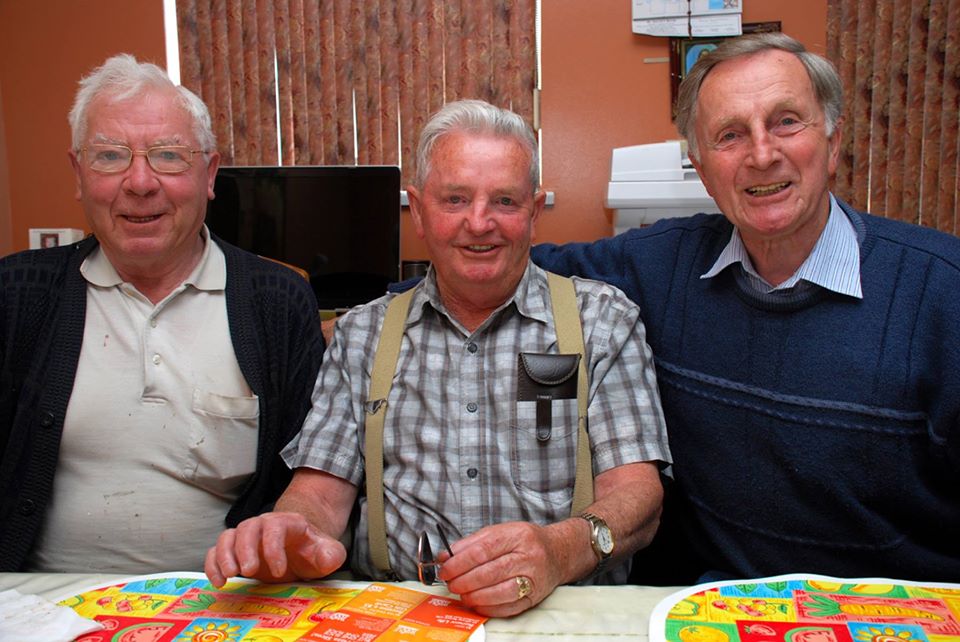
‘THE THREE TOMS’ was a series of engaging interviews of historical interest by Catholine Butler featuring three old friends: (L-R) Tom Butler, Tom Scanlan, and Tom O’Flynn.
One the most engaging and entertaining was a series of interviews I did with three old friends – Tom Butler, Tom O’Flynn and Tom Scanlan. The three had immigrated to Canada in the 1950s and they were delighted to share their memories of home along with the folklore and customs of old Ireland.
Among those memorable people was Chris Whelehan in Edmonton. He launched a highly successful modular home business with customers around the world. He also helped to establish the Wolfe Tones GAA Club and was a passionate supporter of the Gaelic Games.
In Seattle, the late Mick O’Malley established a thriving construction business in that city. As a young man in Ireland, his dream was to immigrate to South Africa.
He applied for work there but waited in vain for a reply. Finally, when no letter arrived he immigrated to the United States.
Years later he learned that a letter confirming work had indeed arrived but his sister didn’t give him the letter because she didn’t want him to go to South Africa.
Mick was a strong supporter of the Seattle Gaels GAA Club and all things Irish in Seattle.
John O’Beirne, owner of the Mad Hatters Superstore, established shops throughout Western Canada which cater to women and men’s accessories. John is very humble about the empire he has built and the resulting employment he created in those various locations.
Ethna Tutt the former president of the Okanagan Irish Society is a mover and shaker for all things Irish in the Okanagan. She helped to establish the first Irish dance school for children in that area. Not only that, she sewed and hand-embroidered the first costumes worn by those dancers.
William Donnellan founder of IRL Construction and Donnellans Irish Pub in downtown Vancouver has continued in record time to add more businesses to his portfolio since arriving in Vancouver.
William is a passionate hurler and supporter of all GAA games. He helped to establish the JP Ryan’s Hurling Club in Vancouver.
Patrick Reid was a gracious man with a witty sense of humour and he shared his fascinating life story and travels around the world with readers of The Celtic Connection.
Reid played a prominent role in so many key moments of Canadian history that touch the very heart of what Canadians hold so dear – particularly the creation of the maple leaf on our national flag.
In addition, as director general of public affairs with the Department of External Affairs, he accompanied the Canadian hockey team to Russia in 1972 in the momentous series between teams representing Canada and the Soviet Union.
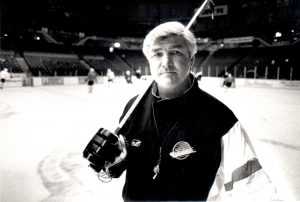
BRIAN BURKE spoke of his pride in his Irish heritage when he was coach of the Vancouver Canucks hockey team in 1993.
Other major figures in the world of hockey that I interviewed for The Celtic Connection included the late Pat Quinn and Brian Burke.
Pat Quinn was the coach of the Vancouver Canucks hockey team. I recall shaking hands when I met him and my whole hand just disappeared into his very large hands.
He was very proud of his Irish roots and was known by the nickname of ‘The Big Irishman’…I could see why. He also told me that he and his family had much enjoyed a visit to Ireland.
Brian Burke was director of hockey operations with the Vancouver Canucks and he also was very proud of his Irish roots. I recall him telling me that one of his favourite dishes was a New England style boiled dinner.
2001: A Year We’ll Never Forget
On September 9, 2001 we has just published that issue and were busy getting ready to distribute the papers.
Colleen came to work early that morning and when I opened the door she was in a state of distress. She said, “the U.S. is under attack.”
We quickly ran to turn on the television just in time to see the second plane hit the World Trade Center in New York. The whole scene was surreal, unbelievable, and horrifying.
We managed to continue distributing the papers that day but soon learned the U.S. border was sealed so couldn’t send to Seattle.
In the aftermath, two very sad interviews remain in mind which encapsulate the events which became known as 9/11.
The first was Eoin Kennedy, manager of the Eastern Region and Southern U.S. States for Tourism Ireland. He was based in New York and was present in the city when the attack took place. He recalls the shock and devastation of that day.
The other was Michael Hurley (former president of the Irish Sporting and Social Club of Vancouver and now Mayor of Burnaby), who was a firefighter in Burnaby at the time.
He had recently returned from New York City where he had attended several funerals of brother firefighters who had perished at the World Trade Centre.
EOIN KENNEDY
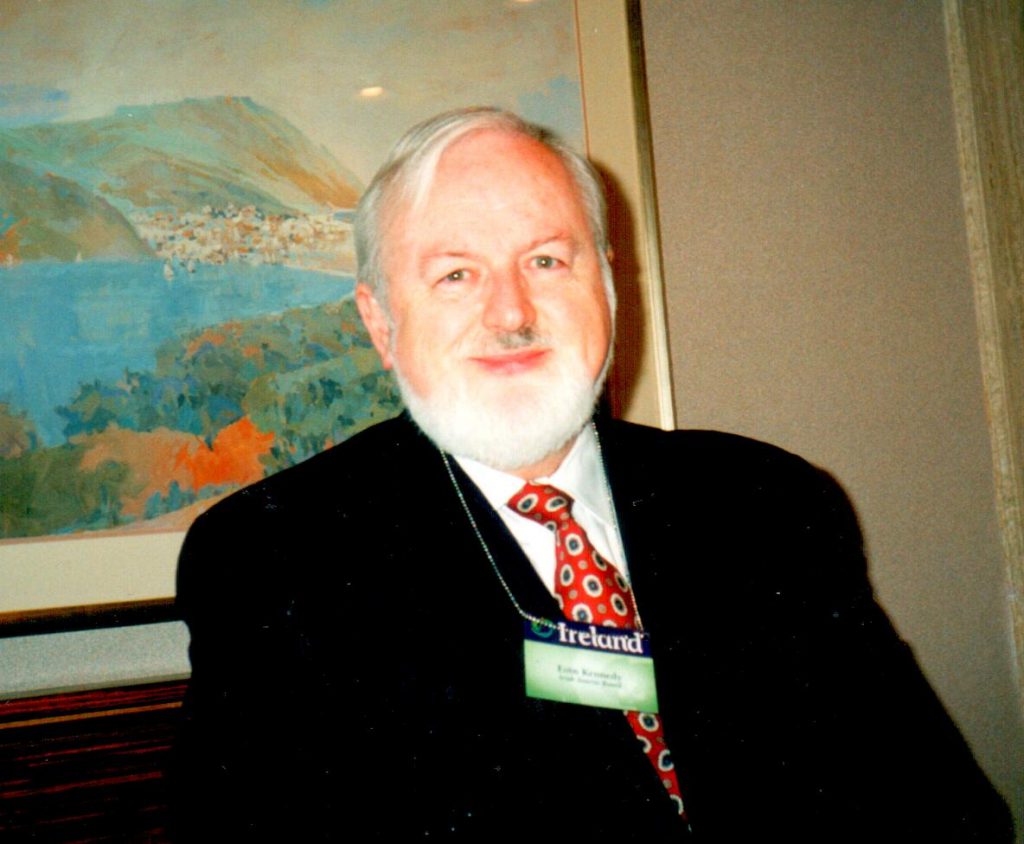
EOIN KENNEDY, manager of the Eastern Region and Southern U.S. States for Tourism Ireland, spoke to Catholine Butler following the devastating 9/11 attack on the World Trade Center in New York City.
In the days that followed 9/11, Eoin recalled, “There’s a pervasive sadness in the city. The terrorist attacks have had an enormous ripple effect on many people. It is estimated up to 4,000 people died in the World Trade Center but those figures are debated daily
“The impact on those families is far reaching, since there were people from up to 60 to 70 different countries among the dead.
“I have heard as many as 300 Irish or Irish-Americans were involved or died in the disaster. As you know, hundreds of firemen died and a huge portion of them were Irish.”
He said, “The New York Times now prints a daily page entitled ‘A Nation Challenged’ which features a brief biography of about 20 or 30 people who were killed at the World Trade Center. It’s a small paragraph about who the guy was, what his job was, his life, his family, his hopes, his dreams, his hobbies and a passport size photograph.
“So many of these guys were in their thirties and fathers of young families. Oh, my God, it’s gut-wrenching reading this every single day – day-after-day.”
He continued, “Actually Catholine, I’m a grown man in my late fifties and I could just cry reading The New York Times coming to work every day. At the bus terminal there’s a whole new altar of flowers every day.
“Then, as you walk through the city on the way to your office, there are fire stations covered with more flowers and candles. I just want to get in to the office and stand in front of a window, take a deep breath, and have a cup of coffee. You just say to yourself, ‘Oh God, how the hell do we continue?’”
Kennedy’s offices were located in Ireland House just across the street from a firehall at Lexington Avenue and 51st Street.
He said, “out in front are pictures of the firemen who were lost in the Trade Center, along with more candles and flowers. Every single firehall in the city has lost from one to five firemen…the stories are heart-wrenching.”
He described the scene saying, “My wife Claire and I went down to Ground Zero and the area is as big as 10 football fields and the debris is almost 100-feet high in some places. It’s staggering to just stand there and see the destruction.
“The smell is dreadful, the dust tickles your throat, and your eyes begin to sting. It’s like you would expect to see after an atomic bomb. It’s an extraordinary sight and your jaw just drops open. You’re left feeling stunned, thinking ‘God Almighty, this thing is unbelievable’.
“There are thousands of dead still there and I think personally they just vaporized at the thousand degree temperature. The one thing they continue to find is a lot of jewelry and among that a pile of Claddagh rings has accumulated.”
In closing, Eoin said, “I’m sorry to sound so depressing, but that’s the way it is. It’s like nothing we have ever experienced or prepared for. It’s one year we’ll never forget.”
MICHAEL HURLEY
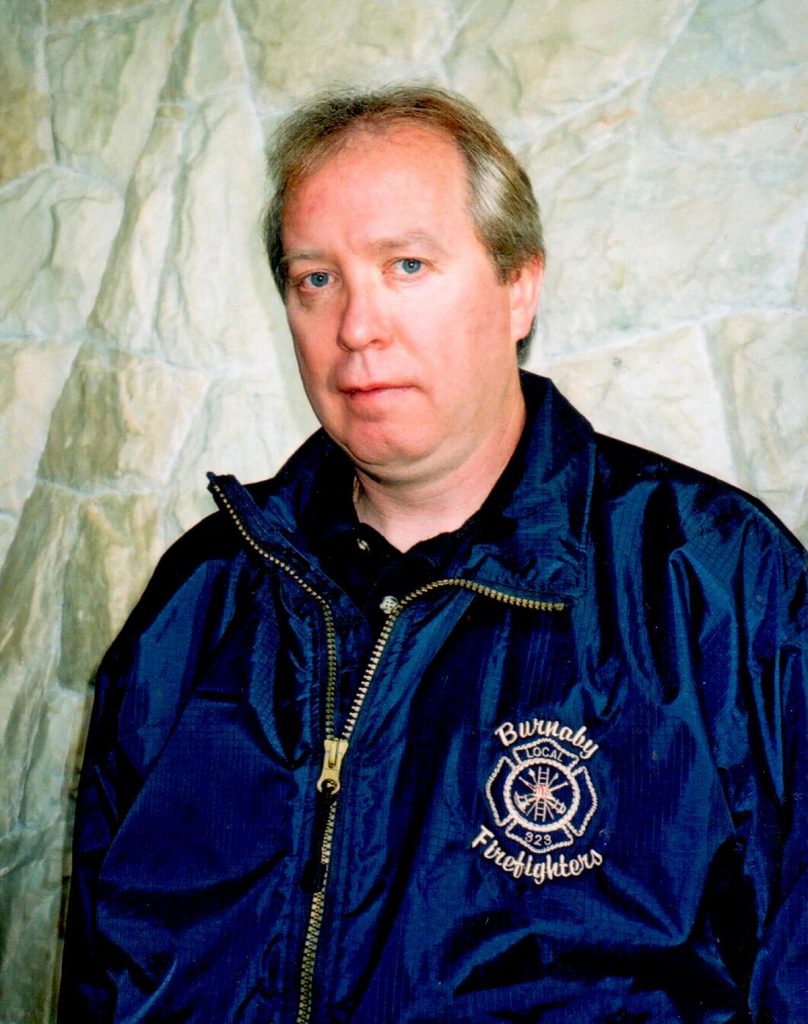
MIKE HURLEY who is now Mayor of Burnaby was chair of the Irish Sporting and Social Club of Vancouver and president of the BC Provincial Fire Fighters Association when he spoke to Catholine Butler following his return from New York City in 2011.
From 1996 to 2001, Michael Hurley was vice president of the Burnaby Fire Fighters Association and president from 2001-2009. He was also the president of the BC Provincial Fire Fighters Association from 2008 – 2016.
After 9/11, firemen from throughout North America went to New York to help in whatever way they could. Mike Hurley went along with firemen from Edmonton, Calgary and Seattle.
Hurley made two trips to New York and he spoke to The Celtic Connection after one of those trips.
He said, “I went to New York twice now, more or less to support the firefighters down there and to attend funerals.
“Because so many firefighters died at the World Trade Center, they’re having a hard time trying to get enough uniformed personnel to attend funerals because of having to cover the extra work shifts of their fallen comrades.
“I attended about 30 funerals while I was there and since there are still 344 funerals to go – that’s almost one funeral a day for a very long time. It’s a very emotional experience. It was hard seeing all those kids without fathers.
“You see so many little kids coming out of the church carrying their dad’s helmet or part of their dad’s uniform, and maybe the widow gets up to speak about her husband and it just tears your heart out.
“We had an opportunity to speak with some of the kids and a few of the wives, but they’re all so devastated they had a hard time even discussing it at that point.”
Mike continued, “You hear so many heart wrenching stories of family members looking for loved ones that died in the Trade Center. We were told of one woman whose husband was of Irish descent and she wanted some part of him as closure for his death.
“She asked the emergency attendant at Ground Zero site if they were able to find anything belonging to him. The attendant asked her if there might be anything that would stand out as belonging to her husband. She said ‘yes….a Claddagh ring.’
“The attendant said, ‘I’m sorry to tell you this and I don’t want to hurt your chances, but that will be up to 200 Claddagh rings that we’re looking for now.’ There was a lot of Irish involvement down there.”
Continuing, Mike said, “I’m originally from Northern Ireland, so I’ve seen a lot of explosion sites, but nothing can prepare you or describe what Ground Zero looks like.
“It’s an 18-acre site, and to put that into perspective, if you look at Brentwood Mall in Burnaby and all the parking lots, it’s about that size of an area that’s been devastated.
“On my arrival home from New York, the first thing I did was to give my daughter a big hug and tell her how much she means to me. As a firefighter you always know that at any time this could happen to you…but that’s our job.”
Thank You, I’ll Miss You!
In closing, I would like to say that we’re eternally grateful to our advertisers and our many original customers who remained with us throughout the life of The Celtic Connection.
I really enjoyed talking to each and every one of you, and along with our dedicated subscribers that is a connection which I will greatly miss.
If our ‘New Beginning’ website is anything like the past 30 years…buckle up! It’s going to be an interesting journey.
The Years of Transformation With The Celtic Connection
By MAURA DE FREITAS
VANCOUVER – When I launched the first issue of The Celtic Connection along with my mother Catholine Butler in 1991, it was a vastly different time. So much so that over the past three decades the entire landscape of the publishing industry — in fact the world of communications — has completely transformed.
To begin with the Internet was in its infancy, cell phones were rare, social media unheard of, digital cameras had yet to be invented, and almost every device was analog. Everything required a lot more legwork, but it also seemed that things were a lot more informal. You could pick up the phone and people actually answered. In addition, the production of a newspaper was vastly different.
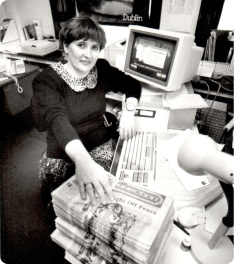
MAURA DE FREITAS [McCay] at work in the office at The Celtic Connection [circa 1993].
It was a never-ending round of running, chasing, haggling, extracting, producing (with just a few wars in between), and then deliveries.
There was always that brief moment of satisfaction when the issue was finally printed. To feel the rush of relief when we opened that paper and knew that it was complete for another month.
People would say with the kindest intention: “Well, now you can rest for another month.” If only they knew! We could only laugh. It was just the briefest interlude before the madness started all over again.
And yet there was that drive, the allure, the downright satisfaction of producing something that gave voice to so many. There was always a sense that our dance card had an expiry date and we were creating a snapshot of a generation.
It was an era where the community was fairly tight knit with lots of dances, concerts and social activities. It was a time when everyone knew everyone else. They might not even be speaking to them but they knew them all the same….and everyone was in the same boat (away from home and missing loved ones!).
Throughout the journey we have been blessed with a legion of supporters, people who arrived just at that very moment we needed them most with offers of assistance.
In fact my mother joked that if you walked in the door just to say hello it was at your own peril because more often than not you were immediately drafted into service.
No experience you say? No problem. You can learn on the job. Here’s a list, we need a stack of papers delivered. And, you know what? So many came back month-after-month to help out in whatever way they could. It was a miracle.
Those angels (and they know who they are) would almost seem to appear out of the nether, often in what we believed was our darkest hour and we couldn’t see a way forward.
One of those remarkable people was Jack Wallace. He took me under his wing and became my mentor and guide before we even launched the first issue. Little did I know what I was actually undertaking.
In hindsight, my lack of understanding was probably my saving grace because anyone knowing the full scope of what would be required wouldn’t even have ventured the first step.
Jack was an old hand in the business. It was in his blood. His father and his grandfather before him were journalists on the beat and both had lived and died the daily grind of press deadlines.
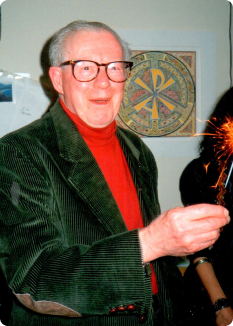
JACK WALLACE at a celebration for The Celtic Connection in 1994.
Sadly his father succumbed to alcoholism — the same disease that haunted so many literary souls of that generation — when Jack was still just a young boy of 12 years old.
He was immediately offered a job in the same newsroom where his father had worked and he began to learn his trade. He remained a lifelong avowed teetotaler knowing only too well the pitfalls of the industry.
Jack worked in New York and San Francisco with some of the most renowned luminaries in the business, including Walter Winchell and William Randolph Hearst. He travelled throughout the United States with the Hearst Corporation. His talent was redesigning newspapers that needed new life to survive — creating a fresh look to thrive in a cut-throat industry. In fact, he became known throughout the industry as ‘the newspaper doctor’.
When we met in the early ‘90s Jack was retired. A mutual friend mentioned to him that she knew someone planning to launch a newspaper geared specifically for the Celtic people and his ears had perked up. He informed me that he was inspired by the great William Wallace and identified strongly with his Scottish heritage. He came to Canada when he was contracted to do a major redesign of the Vancouver Sun newspaper to help mark Expo ‘86.
Born and raised in New York City, Jack never found the need to learn how to drive as he was accustomed to taking taxis from one destination to the next. In Vancouver his devoted wife Jan was his designated chauffeur. He was the most fascinating and eccentric character, twinkling blue eyes, with a little black beret perched on the side of his head — definitely from another era. In more lighthearted moments he would regale us with stories of his wild and crazy days in the media industry but when he was working he was deadly serious.
After the first issue it began to dawn on me just how much intense energy was actually involved to maintain the pace. Jack steadied me and helped to keep me focused. It was with his help that I started to understand what I needed to learn before I could fly on my own.
But I will never forget that feeling when I delivered that first printing down to the old Irish Centre on Prior Street. The bundles were snapped up and as I looked across the room all I could see were faces buried in the first edition. It was quite intoxicating. After working so many hours through blood and sweat, to see people actually cracking open the pages and reading the content just about made me swoon. I was hooked.
We established offices in a heritage building on Hastings Street in downtown Vancouver and in those early days it was a hive of activity. In fact, it was the epicenter of the Celtic storm with people dropping by to say hello, phones ringing, and all manner of advice and suggestions coming our way. Production meant long nights with little or no sleep, sometimes for days on end, to meet our deadlines. It was a domino effect and coordinating all the pieces was exhausting.
One day Professor Robert O’Driscoll who established the Chair of Celtic Studies at St. Michael’s College with the University of Toronto called to offer congratulations on the new paper. I thanked him for his kind words as he commented on the professional layout and design but I told him “truthfully it’s chaos and God only knows how long we can survive.”
His words made a deep impression. He said: “Maura from your perspective at the centre of the storm it might feel like chaos, but the further back you stand and look it’s a beautiful creation. Don’t despair, don’t give up. Persevere it gets better.”
He gave me hope that The Celtic Connection was indeed reaching people and it resonated for them. That’s all I could ask for.
Marie Bruce was another delightful soul who arrived one day to offer herself as a volunteer.
She was immediately assigned to answer phones and chase money of which we were very much in need (a chronic condition which never really seemed to be resolved).
One day I arrived in to learn from Marie that I was going to New York City to accept an award as one of the ‘Top 100 Irish-Americans of 1993’ for my work on the paper.
I thought surely someone is pulling my leg but no, it was the truth.
My immediate response was “there’s absolutely no way I can go to New York, I can’t even afford to go around the corner right now, and besides the fact I’ve got a newspaper to publish.”
With her usual practical, down-to-earth advice, Marie dismissed my misgivings and said, “Of course you’re going to New York Maura, you’re not going to miss this opportunity!”
And somehow, before I knew it, there I was at the Plaza Hotel right across from Central Park in New York rubbing shoulders with the bourgeoisie and meeting people that I could once only have dreamed of encountering.
All I could do was laugh at the absurdity of it all. First of all, I really doubted that I even qualified for the honour and secondly, I could just about hear the pennies jingling in my pocket.
But it was great fun all the same and I met some of the most amazing people — some lifelong friends — as a result.
One very fortunate connection was the head of Aer Lingus in New York who offered a contra deal to The Celtic Connection.
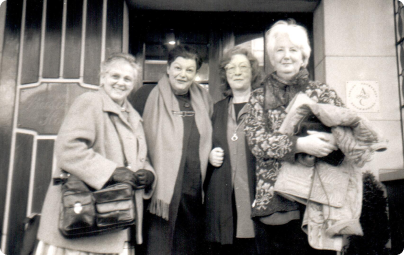
ELINORE DETIGER [second from left] pictured on the front steps of Buswell’s in Dublin along with [L-R] Isabelle Smyth, Gillian Kean, and Annabelle Watson at the Global Women’s Network conference in February 1994.
Seemed like a great idea to me and it allowed me to travel — again on a wing and a prayer — back and forth to Ireland via New York several times a year. My father had moved back home to Ireland so it suited me very well.
Another serendipitous encounter was meeting Elinore Detiger. She was a mysterious wealthy philanthropist who travelled the world bringing together people working at a grassroots level to help promote unity and peace in the world.
Along with helping so many others, she was there for us in so many ways, never making demands or requests of any kind, just merely stepping forward to assist and support when we needed her the most.
She was introduced through another friend, author Charles Ferris who had written a book called: ‘Angels of Mercy: A Dream of Peace for Ireland’.
Elinore invited me to Ireland on a number of occasions, once for an all-expenses paid trip to The Global Women’s Network conference at Buswells Hotel in the heart of Dublin.
Located just a stone’s throw from Leinster House, Buswells is a hugely popular meeting place for Irish politicians and is commonly known as ‘the third house of the Oireachtas’.
This global gathering was an incredible experience. It allowed me to meet women from around the world, from all walks of life, rich and poor, who came together to share and learn how to network for a better world. It was refreshing and enlightening.
On another occasion, just when I thought I was at the end of the road, Elinore swooped into town and whisked me away to the sacred isle of Iona off the west coast of Scotland.
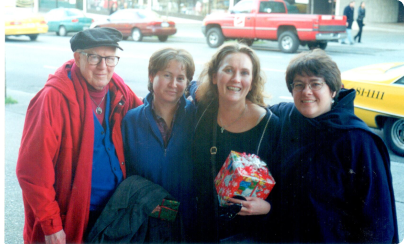
EDITORIAL STAFF working on The Celtic Connection at Christmas 1999 [L-R] Jack Wallace, Alicia Martin, Maura De Freitas, Andrea Law.
Along about this time, a conspiracy of sorts took place.
A year earlier Tom Butler had lost his beloved wife to cancer and it was a great sorrow for him and his family.
Tom was a proud Mayo man. He was one of the founding members of the Vancouver Irish Sporting and Social Club (ISSC) and a stalwart club supporter. He was also known over the years in the Irish community for hosting great house parties where people sang and danced into the early morning hours. His door was always open to his fellow countrymen and women with many finding a start in a new country and a new city as guests at the Butler residence. For this reason Tom had a great many friends who were concerned about his well-being and hoping that he could move on with his life.
I mentioned earlier about all the social events we attended in this period, and my mother who was single was often seated beside Tom for company. It didn’t go unnoticed that when they were together there was a lot of laughter and they seemed to get along like a house on fire.
So began a plot to bring those two together — a marriage so to speak of the ISSC and The Celtic Connection.
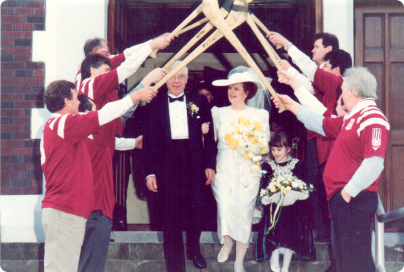
TOM AND CATHOLINE Butler’s 1995 wedding was a marriage of the Vancouver Irish Sporting and Social Club and The Celtic Connection.
There were multiple perpetrators in the plot with the ultimate goal of seeing two people happy….and so it came to be. A massive house party was held at Tom Butler’s following the wedding vows at St. Augustine’s Parish in front of Father Mohan. And a new chapter had begun.
Tom treated me as another daughter and he took it upon himself to look out for me. We formed a very close bond built on mutual respect. He was very proud of our work on The Celtic Connection but he was one of my greatest supporters.

CATHOLINE BUTLER in the Vancouver St. Patrick’s Day Parade as Irish Woman of the Year.
I can now look back and reflect what a very long distance we have come from those early heady days. We have grown into our identity and became stronger thanks to those challenges.
Along the way we made countless friends and I firmly believe we served our diverse Celtic community to the best of our ability. We put our heart and soul into the project and helped bring together pan-Celtic groups across Western Canada and the U.S. Pacific Northwest. In doing so, we gave voice to hundreds if not thousands in a very unique way. Some of our proudest moments have been the celebrations and community support for our work over the years.
I was particularly thrilled when my mother was presented with the Lifetime Spirit Award by the Vancouver Irish Sporting and Social Club. That was a wonderful night of bon ami. She was also presented with an award by a Canadian prime minister, on behalf of the National Ethnic Press and Media Council of Canada. It acknowledged the role of The Celtic Connection in promoting equality, respect to human values and human rights. And for co-operation and understanding among the members of the various cultural groups of Canadian society.
Another highlight was when the Men’s Western Canada GAA Championship Cup was named the Tom Butler Cup. It gave us tremendous joy to see his many years of volunteer work recognized in that way.
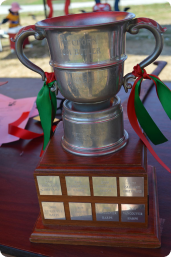
TWO Western Canada GAA Championship Cups: (L) The Tom Gibbons Women’s Championship Cup and (R) The Tom Butler Men’s Championship Cup.
Shortly after the launch of The Celtic Connection the Irish Women’s Network (IWN) was formed by Mary Hatch who was inspired by the election of Mary Robinson, the first woman to hold the office of President of Ireland. It was her gesture of placing a candle in the window of Áras an Uachtaráin to welcome home the souls of the diaspora that particularly spoke to Irish scattered throughout the world.
The IWN has been an outstanding friend and both Catholine and myself were each honoured with the Irish Woman of the Year award on various years and that was a great boost for all of us working on the paper.
There have been so many changes over the years and it was a great privilege to be present to witness and to record many of those developments.
In 2018 the new Consulate General of Ireland was established in Vancouver thanks to a huge influx of young Irish migrants following the collapse of the Celtic Tiger a decade earlier. This was the first new Irish diplomatic mission to open in Canada since the Embassy of Ireland opened in Ottawa in 1939.
Frank Flood and his wonderful team have brought new vitality and cohesiveness in a growing and dynamic community. In this current time of personal and economic challenges for so many, their support and resourcefulness has been an immense asset.
Now, as we emerge at the end of our journey in publishing a print edition of The Celtic Connection, it’s remarkable to reflect on how the local Irish community has also transformed. From our perspective, we’ve also evolved and grown – no longer caterpillars, it’s time to soar on our own wings.
What the future brings we can only imagine but whatever it does the gifts of working with the various Celtic communities across western Canada and the U.S. Pacific Northwest for almost 30 years have been priceless.
Sending love and best wishes to all of you who have stood in solidarity with us through the storms. You’re the rock that supported us. This is a new day and a new beginning. May blessings be upon you.
Maura x
Maura De Freitas
Editor/Publisher
The Celtic Connection
POSTSCRIPT: I would be remiss if I did not mention the key role that my mother Catholine Butler played in publishing The Celtic Connection. Not only did she handle advertising sales and promotions, she also managed distribution of the paper each month. In addition, she wrote articles, travelled throughout western Canada and the Pacific Northwest to interview countless personalities, and generally worked to help create an historical archive of the period 1991-2020. She also served as the public relations core of the newspaper and helped smooth out the edges at times when I might have been considered a little less than diplomatic. The Celtic Connection would never have survived without her support.
It was almost 30 years ago when Maura De Freitas (McCay) and her mother Catholine Butler launched the first edition of The Celtic Connection and it’s been an interesting journey.
Despite all the ups and downs it has been one of the most exciting and rewarding adventures of our lives. You can read our stories here.
When we started out we were filled with youthful idealism but without the backing of countless volunteers and financial sponsors we could never have produced the body of work we did. We are forever grateful for your support.
In our photo gallery section you will find some highlights of past issues. These pages are filled with the stories and photos of some of the remarkable people we have been privileged to serve.
We hope you will agree this is a an historical archive and a snapshot of a generation for some of the Celtic communities across Western Canada and the U.S. Pacific Northwest.
In this time of the COVID-19 pandemic it’s time to call the end of an era and the start of a new beginning.